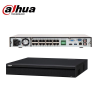IP cameras don't use a lot of bandwidth. Like maybe 8mbps max. And keep in mind this is all local bandwidth too. It shouldn't affect your outbound bandwidth, so streaming, youtube, etc will all be unaffected.
Cameras going thru a wifi router can absolutely impact the rest of the system. We have countless people come here with problems and once they isolated the cameras and removed them from the wifi router, everything cleared up.
You would be surprised how quickly that data adds up.
My cameras are on their own isolated network that does not touch the router or the internet. On my isolated NIC, my cameras are streaming between 280Mbps to 350Mbps depending on motion. This is full-on, never stopping to take a breath. Even if someone has a gigabit router, a 3rd of non-buffering 24/7 data will impact its speed.
People will say stuff like "we stream 5 TVs with no problem". Yeah that is because streaming services like Netflix and others buffer the video. It may buffer 15 seconds to a minute or more of video. This allows it to send some video, pause to let something else on the network use the internet, send some more video, and repeat process.
These cameras do not buffer and all full-on nonstop. Pull the ethernet cable and the surveillance camera stops instantly. Pull the internet cable while watching Netflix and you may get an additional minute of watching the video.
Cameras connected to Wifi routers (whether wifi or not) are problematic for surveillance cameras because they are always streaming and passing data. And the data demands go up with motion and then you lose signal. A lost packet and it has to resend. It can bring the whole network down if trying to send cameras through a wifi router. At the very least it can slow down your entire system.
Unlike Netflix and other streaming services that buffer a movie, these cameras do not buffer up part of the video, so drop outs are frequent. You would be amazed how much streaming services buffer - don't believe me, start watching something and unplug your router and watch how much longer you can watch NetFlix before it freezes - mine goes 45 seconds. Now do the same with a camera connected to a router and it is fairly instantaneous (within the latency of the stream itself)...
The same issue applies even with the hard-wired cameras trying to send all this non-buffer video stream through a router. Most consumer grade wifi routers are not designed to pass the constant video stream data of cameras, and since they do not buffer, you get these issues. The consumer routers are just not designed for this kind of traffic, even a GB speed router.
So the more cameras you add, the bigger the potential for issues.


